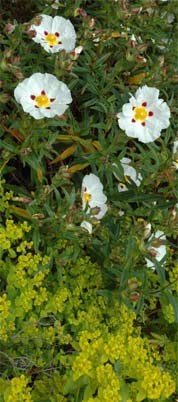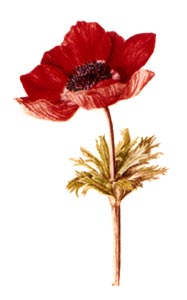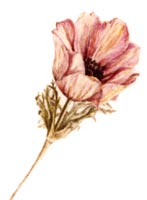

Garden Design
 Our gardening year begins in January with aconites, a plant native to Cambridgeshire, alongside a collection of interesting snowdrops. Soon after come cyclamen and hellebores, both Helleborus orientalis in many different shades and another Cambridgeshire native, Helleborus foetidus, with its acid green bell-like flowers and leaves spread out like fingers. Next are daffodils and tulips, concentrating on species tulips. May and June bring plants with a Mediteranean background, cistus, rock rose, eryngium and thistles,alongside the main flowering of herbacious perennials in the Walled Garden. Autumn is the time for more cyclamen, autumn crocus, colchicum, nerine and the yellow sternbergia from Greece. The bare branches of true winter show off the shape of the trees and shrubs to their best advantage, especially when contrasted with evergreens and even more so when edged with hoare frost and a sprinkling of snow. Each division of the garden reaches its climax at a different time.
Our gardening year begins in January with aconites, a plant native to Cambridgeshire, alongside a collection of interesting snowdrops. Soon after come cyclamen and hellebores, both Helleborus orientalis in many different shades and another Cambridgeshire native, Helleborus foetidus, with its acid green bell-like flowers and leaves spread out like fingers. Next are daffodils and tulips, concentrating on species tulips. May and June bring plants with a Mediteranean background, cistus, rock rose, eryngium and thistles,alongside the main flowering of herbacious perennials in the Walled Garden. Autumn is the time for more cyclamen, autumn crocus, colchicum, nerine and the yellow sternbergia from Greece. The bare branches of true winter show off the shape of the trees and shrubs to their best advantage, especially when contrasted with evergreens and even more so when edged with hoare frost and a sprinkling of snow. Each division of the garden reaches its climax at a different time.
 Much of the flower colouring in the garden is muted, with soft shades acting as a foil to spot planting of stronger hue. Crimson and orange are set off with the greens and the greys of Mediteranean foliage. Self-seeding is encouraged and the resulting seedlings coaxed and pruned to fit in with the overal design, although there is little segregation by size or form. Roses and clematis spray out from the tops of trees and bulbs pop up between cobbles and through gravel. The prevailing impression is of ebullient growth to the point of raising fears for the survival of the more delicate species. The garden designer, though not entirely ousted, has had to yield pride of place to the plantsman.
Much of the flower colouring in the garden is muted, with soft shades acting as a foil to spot planting of stronger hue. Crimson and orange are set off with the greens and the greys of Mediteranean foliage. Self-seeding is encouraged and the resulting seedlings coaxed and pruned to fit in with the overal design, although there is little segregation by size or form. Roses and clematis spray out from the tops of trees and bulbs pop up between cobbles and through gravel. The prevailing impression is of ebullient growth to the point of raising fears for the survival of the more delicate species. The garden designer, though not entirely ousted, has had to yield pride of place to the plantsman.